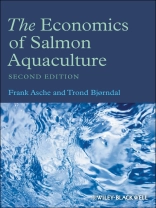First published in 1990, The Economics of Salmon Aquaculture
was the first book to systematically analyse the salmon aquaculture
industry, from both a market and production perspective. Since
publication of the first edition of this book, the salmon
aquaculture industry has grown at a phenomenal rate, with salmon
now being consumed in more than 100 countries worldwide. This
second edition of a very popular and successful book brings the
reader right up to date with all the major current issues
pertaining to salmon aquaculture.
Commencing with an overview of the production process in
aquaculture, the following chapters provide in-depth coverage of
the sources of the world’s supply of salmon, the growth in
productivity, technological changes, environmental issues, markets,
market structure and competitiveness, lessons that can be learnt
from the culture of other species, optimal harvesting techniques,
production planning, and investment in salmon farms.
Written by Frank Ashe and Trond Bjørndal, two of the
world’s leading experts in the economics of aquaculture, this
second edition of The Economics of Salmon Aquaculture
provides the salmon aquaculture industry with an essential
reference work, including a wealth of commercially important
information. This book is also a valuable resource for upper level
students and professionals in aquaculture and economics, and
libraries in all universities and research establishments where
these subjects are studied and taught should have copies of this
important book on their shelves.
Tabela de Conteúdo
Preface.
1 Introduction.
2 The Production Process in Aquaculture.
2.1 Salmon production.
Bibliography.
3 The Supply of Salmon.
3.1 Farmed salmon production.
3.2 Wild salmon production.
3.3 Regulation of salmon aquaculture.
3.4 The growth of large multinational companies.
Bibliography.
4 Productivity Growth and Technological Change.
4.1 Declining costs.
4.2 Scale.
4.3 Structure of production costs.
4.4 Smolt production.
4.5 Improved feed quality.
4.6 Diseases and increased survival rates.
4.7 Breeding.
4.8 Cycles in profitability.
4.9 Catching up: regional differences.
4.10 Productivity development in Norway relative to otherproducers.
4.11 Cost reductions in the supply chain.
Bibliography.
5 Environmental Issues.
5.1 The fi sh meal trap.
5.2 Local issues.
Bibliography.
6 Markets for Salmon.
6.1 The European Union markets.
6.2 The Japanese salmon market.
6.3 The United States salmon market.
6.4 The Russian market.
6.5 Price development.
Bibliography.
7 Competitiveness and Market Structure.
7.1 What is a market?
7.2 The salmon market.
7.3 The size of the market.
7.4 Salmon marketing.
7.5 Trade restrictions.
Appendix: a market model.
Testing for market interactions.
Bibliography.
8 Lessons for Other Farmed Species.
8.1 Other farmed species.
8.2 Lessons from other farmed species.
Bibliography.
9 Optimal Harvesting of Farmed Fish.
9.1 A biological model.
9.2 Bioeconomic analysis.
9.3 The rotation problem.
Appendix: optimal harvesting of farmed fish.
A biological model.
Bioeconomic analysis.
Harvesting costs.
Feed costs.
Feed and harvesting costs.
The rotation problem.
Optimal harvesting: examples.
Bibliography.
10 Production Planning in a Salmon Farm.
10.1 Cash fl ow analysis.
10.2 Smolt release and biomass growth.
10.3 Sales revenue.
10.4 Feeding costs.
10.5 Net present value.
10.6 Selective harvesting.
11 Investment in a Salmon Farm.
11.1 A production plan.
11.2 A liquidity budget.
11.3 Cost of production.
11.4 Investing in a new aquaculture company.
11.5 Licence value.
11.6 Buying a fish farming company.
References.
Index.
Sobre o autor
Frank Asche is Professor at the Department of Industrial
Economics, University of Stavanger, Norway.
Trond Bjørndal is Professor and Director of the
Centre for the Economics and Management of Aquatic Resources
(CEMARE), University of Portsmouth, UK, and Professor II, Aalesund
University College, Norway.












